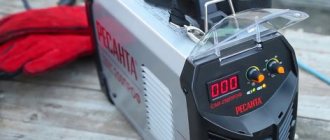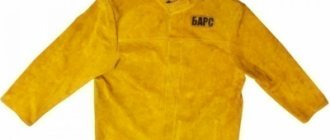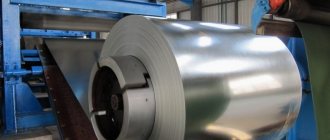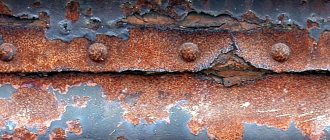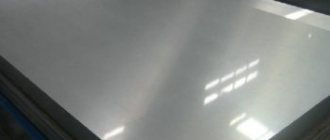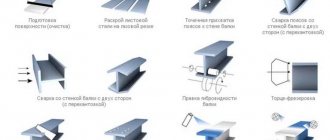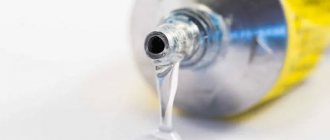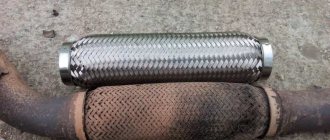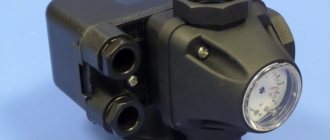- — Equipment and material of the suit
- — Features of clothing for a welder
- — Welder suit protection class
- — Rating of the best suits for welders
- — The best winter welder suits
- — The best summer welder suits
- — Which welding suit is better to choose?
In any field of activity, workplace safety is a major requirement.
This is not only compliance with safety regulations, but also correctly selected workwear. For a welder, a mandatory working condition is the presence of special clothing that will protect him from metal sparks and drops. A good welder's suit should be comfortable while working and correspond to the specifics of the job. There are many clothing models on the market that differ in their configuration and characteristics. First of all, you should consider what the workwear consists of. This could be overalls, overalls or a jacket and trousers.
The overalls are comfortable, as they are one-piece and reduce the penetration of sparks under clothing. But you won’t be able to remove it quickly if an unforeseen situation arises.
The protective characteristics are affected by the material from which the suit is made. The following types of material are used in production:
- Tarpaulin
. The most common option. It contains linen and cotton yarn. Before sewing, the fabric is impregnated with special substances that make the material resistant to fire and prevents the penetration of moisture.
- Split leather.
Reliably protects the body from sparks and drops of hot metal. As a rule, such material is used to cover those parts of clothing that are more exposed to sparks and splashes. There are models of workwear in which the entire top layer is made of this material. But the fabric has a significant drawback - air impermeability.
- Suede
. In most cases, it is used for sewing individual elements, less often - for sewing entire work clothes. The fabric is not picky at high temperatures or humidity.
- Hephaestus
. This material is similar to tarpaulin. It is based on pure cotton with a special fire-resistant treatment. The peculiarity of the fabric is that hot splashes roll off the surface, rather than solidify on the fabric. The disadvantage of the material is its high cost.
- Moleskin
. This material is distinguished by its high strength. The basis is cotton with an unusual weave, resulting in a dense structure. Despite the density, the fabric provides good air exchange.
There is another modern material - aramid fabric.
Its main feature is its light weight, so it will not cause discomfort during operation. The material is not subject to mechanical stress and is resistant to elevated temperatures.
According to the design features, the suits are sewn according to a single pattern with a straight cut. There are some changes that improve wearing comfort, but the main thing is the strict design and straight silhouette. Design features when sewing include:
- Sleeve
. A special sleeve design is used, which does not hinder the worker’s movements, repeats exactly all his movements and does not leave folds. Thanks to this, the hot metal will not get into the folds, but will simply roll off the sleeve.
- Pockets
. To prevent hot scale from getting into them, the pockets are sewn with special valves that close them. If these are side pockets, then they should have a deviation of 10 degrees.
- Central clasp.
As a rule, it is sewn offset to the side, as well as with an additional protective valve to avoid contact with hot substances.
It is also important that the suit has ventilation holes. With their help, an optimal microclimate will be maintained inside. The elements of the suit are connected to each other with reinforced thread to improve resistance to open fire.
There is one more parameter that people pay attention to when purchasing workwear - the level of protection.
For welder's workwear, the following classes are distinguished:
- first
– relevant when the welder is working at a distance of 2 meters from the source of sparks;
- second
– minimum distance of 0.5 m, suitable for manual welding;
- third
– relevant when working in a confined space or inside a container.
Rating of the best suits for welders
Based on the stated characteristics and selection criteria, a rating of welding suits for 2022 was compiled. For ease of selection, it was divided into two categories: for winter and summer wear.
| Model name | Rating | Price, ₽ |
| The best winter welding suits | ||
| 1. ZEUS PLUS-3 | 9,8/10 | 25600 |
| 2. Firer 1 KOS341 | 9,7/10 | 13130 |
| 3. WORKER 3 class. protection (fabric 100% cotton, 500) | 9,5/10 | 16500 |
| 4. TS-83 type B | 9,3/10 | 18000 |
| 5. Canvas suit KOS390 | 9,1/10 | 4100 |
| 6. Welder suit “Mars” | 8,9/10 | 10300 |
| 7. Prior suit | 8,7/10 | 23700 |
| The best summer welder suits | ||
| 1. TS – 43 type A | 9,9/10 | 22000 |
| 2. Premium 2 class. protection | 9,7/10 | 11200 |
| 3. Firer 1 KOS410 | 9,6/10 | 6550 |
| 4. Hercules suit 105-0016-01 | 9,4/10 | 5500 |
| 5. Canvas suit OP with overlays KOS309 | 9,2/10 | 2100 |
| 6. TORCH 50585000 | 9/10 | 3800 |
| 7. Reinforced suit 1 class. protection | 8,9/10 | 1800 |
Suit "Prior"
The name of the model comes from the material from which it is made. The fabric is resistant to high temperatures. Resistance is increased by a special silicone coating treatment.
The insulation of the suit can be unfastened if necessary. It is attached to the suit using buttons. There is a high collar that is fastened tightly with adhesive tape. The product belongs to the third class of protection.
pros
:
- high quality seams and tailoring in general;
- long service life, wear-resistant;
- comfortable in various weather conditions.
Minuses
:
- high price.
Welder suit "Mars"
The model from a well-known manufacturer is made of high-quality cotton material, fire-resistant impregnated with Proban and a density of 410 g/m². Since this is a winter suit, it is insulated with fire-resistant synthetic material with a density of 100 g/m².
The jacket has 3 layers of insulation and the trousers have 2 layers. The lining is 100% cotton (calico).
The suit is classified as protection class 4, which characterizes it as workwear designed for work in special climatic conditions. A special feature of the model is the presence of an insulated belt and elastic straps on the trousers.
This increases the comfort while wearing them.
pros
:
- a large number of pads increases the degree of safety;
- the presence of internal pockets in the design;
- reliably protects against low temperatures and frosty winds;
- the insulation can be removed if necessary.
Minuses
:
- due to the three-layer insulation, movements may be slightly constrained;
- For the specified characteristics, the cost per unit is a little high.
Advantages and disadvantages of each material
Since the material plays a major role in any jumpsuit or suit, it is important to carefully study them. This will help you find the best option that will protect the employee in any situation.
- The first option is a tarpaulin. This material is considered one of the oldest, as it has been used for decades. But it has not lost its relevance and popularity. Cotton and linen yarn are used in its production. To achieve good technical performance, during the manufacture of the suit, a special impregnation is carried out, which prevents the penetration of liquid and also protects against ignition. After this operation is completed, a special film appears on the canvas.
- Leather split. A quality product that will protect a person from sparks and molten metal. Often this is the material that most modern manufacturers prefer to use. But sometimes it is used to sew certain parts. However, this design has one drawback - air impermeability, which will make working in such overalls or suit inconvenient.
- Suede leather. This material meets safety requirements, so it is often used to make some elements of a jacket or trousers. It is also suitable for sewing a whole product, but this is rare. The peculiarity of the design is its attractive appearance and preservation of positive properties even after prolonged exposure to water.
- Some manufacturers refuse to use tarpaulin and replace it with 100% cotton with special impregnation. To obtain such fabric, a special weave of threads is used. Also, during manufacturing, the product is impregnated with a special solution, which gives the finished product all the necessary properties. The peculiarity of this option is that the hot spray gently rolls off the outer part and does not freeze. The only drawback is the high cost.
- Moleskin. The advantage of this option is high strength. The surface has a slight shine that attracts attention. This suit or overalls is made using thick cotton yarn. Thanks to the unusual weave, the fabric structure is dense and there is good air exchange.
Scientists are always finding new and interesting combinations of chemical components. Therefore, a particularly durable material based on aromatic polyamide has recently been produced. Sometimes it is also called aramid fabric. Such products are highly resistant to temperatures and are not subject to mechanical stress. But the most important advantage of this design is its small weight, so a person will feel comfortable.
Canvas suit KOS390
The model is made of tarpaulin based on flax and cotton. Material density 550 g/m², lining made of 100% cotton fabric. The insulation is made of batting.
The jacket is fastened with buttons, which are hidden by a canvas lining. The trousers are loose-fitting, without additional reinforced zones. Of the proposed winter models, this suit is one of the cheapest. Let's say when working two meters from the source of hot splashes.
pros
:
- the collar is sewn from cotton fabric, which is why the neck does not rub;
- increased density of the material used;
- inexpensive model;
- Pure cotton lining.
Minuses
:
- The insulation is dense, which can hinder movement during work.
TS-83 type B
The product belongs to all protection classes. The package includes a thermol helmet. The density of the material differs in different areas of clothing.
So the front part has a density of 500 g/m², the back – 310 g/m². this is explained by the fact that the front part is more vulnerable to splashes of hot metal, so the compaction in this area is greater.
Since this is a winter model, it has insulation, which can be removed if necessary. The helmet also has insulation.
The jacket is fastened with a zipper and has a placket on top. The product has pockets that are protected from splashes. The package includes a belt, but it can be worn if desired.
pros
:
- a removable lining is provided;
- high quality material;
- The package includes a helmet with insulation;
- shock-absorbing pads on elbows and knees;
- the lining is removable;
- There are ventilation holes on the back.
Minuses
:
- the material is not resistant to water;
- overpriced.
WORKER 3 class. protection (fabric 100% cotton, 500)
The cut of the product was used as in most other models - a straight silhouette, a central fastener with loops and buttons with a protected flap. A special feature of the product is the ability to remove the hood if it is not needed and fasten it for protection from the wind.
The collar is high and turned down, which increases wearing comfort. The jacket has wide pockets on the sides.
The trousers have a fold-over front, button fastenings, and pockets with side fastenings. The suit has a reflective strip at the bottom of the trousers and in the chest area of the jacket. The insulated lining is removable. The suit has been assigned the third level of protection.
pros
:
- high-strength material is used for sewing;
- there are pads on the knees and elbows, which provide additional function;
- removable hood, which can be removed if necessary;
- high collar that protects the neck and face;
- wide and comfortable pockets;
- presence of SOP of 50 mm.
Minuses
:
- not found.
Proper Wearing
To prevent burns and injuries with serious consequences, you must not only carefully select the welder’s uniform, but also strictly follow the rules of wearing:
- Trousers are prohibited from being tucked into boots - they are worn only over any shoes.
- In the elbow area, the jacket has additional padding made of leather or thick canvas, and the knees are equally protected.
- Fasteners and buttons are protected from exposure to high temperatures by special strips.
Before starting work, the performer must remove from his pockets any unnecessary items that could cause a fire.
Firer 1 KOS341
A model of an insulated version, where the heat-protective lining is fastened with loops and buttons. A suit of 1st class of protection, relevant when working in various weather conditions and climatic zones. The jacket is fastened in the center with a hidden button fastening and a turn-down collar. The product has reinforced pads on the front of the trousers and on the sleeves.
There is a 50 mm reflective tape at the bottom of the trousers and on the chest. The product protects during welding operations, when small amounts of sparks and splashes occur. Relevant when working at a distance of 2 meters while servicing automatic welding lines or when mechanically cutting metal.
pros
:
- average affordable price;
- high-quality breathable material;
- number of linings (jacket 3 layers, trousers - 2);
- ease of care;
- The seams are made with high quality.
Minuses
:
- A three-layer jacket may restrict movement a little.
ZEUS PLUS-3
This product has made it to the top of the best welding suits because of its durability and reliability. The model corresponds to protection class 3. The material is resistant to abrasion, which increases the service life of the workwear.
Also, splashes from hot metal, as well as various contaminants, do not accumulate on the fabric. The product reliably protects against strong gusts of wind. In addition to the suit, the package includes a hood and a special insulated lining.
The collar is high, which protects the neck from frost. Reflective lines and ventilation holes are provided. The knees have holes for reinforced padding. This model provides maximum protection for the worker during welding work.
pros
:
- stylish and attractive design;
- high quality tailoring;
- zippers;
- reliably protects from wind and frost.
Minuses
:
- high price per unit.
Additional items of workwear
Since welders often have to work in a sitting and standing position, a leather apron that can cover almost the entire body would be useful for the welding suit they use. If metal or slag particles accidentally get on the apron, they will not cause damage to the workwear. A set of winter clothing for a welder should contain warm mittens or gloves with gauntlets. The robe must have special ventilation holes. The fact is that it is made of high-density material and can be hot in it.
The welder's shoes must meet special requirements. These are usually shoes or boots, the soles of which must be made using special non-stick rubber, which can protect the shoes from exposure to flame and electricity.
Shields and masks
From all of the above, it becomes clear that a welder needs a suit to protect his body. What about the eyes, which can be seriously damaged by burns and radiation? For this purpose, manufacturers offer special shields, which over time were replaced by special masks made of cardboard and “Chameleon” masks. Special glasses can also be used to protect the eyes.
- Today, shields are used very rarely due to the fact that they are very inconvenient to use during work. The worker has to hold the shield with one hand and do the work with the other.
- A mask made of thick cardboard with a viewing window made of a light filter is much better suited for this. But it also has a serious drawback - first the person must look at the place of work and only then lower the mask with a nod of the head or hand. However, even in these few seconds his vision can be seriously damaged.
- The Chameleon mask is a more practical way to protect your eyes because it does not need to be lifted before use. Here glass is used as a replacement for a light filter, which darkens when the arc is ignited. If necessary, an employee can customize such a mask to suit his needs. Thus, he will be able to create the most comfortable working conditions for himself.
Welders' jobs involve high health risks as they regularly face exposure to high temperatures, metal spatter, slag particles and sparks that can cause severe burns and injuries. In order to protect against such phenomena, they must perform their work only in a special welding suit.
However, these clothes must meet certain requirements and take into account their working conditions. Particular attention here should be paid to the material from which the welder’s workwear is made. It should not only provide reliable protection from adverse factors, but also provide the worker with fairly comfortable conditions for welding work.
Equally important is the quality of the welding suit. To increase strength, the weakest points should be reinforced to reduce the risk of damage and thereby increase worker safety.
It is also important to ensure that not only the body, but also the eyes are protected during work. To do this, a set of welding clothing must include a special mask. Moreover, it should not only provide a high level of protection, but also be convenient to use. Only if the worker is equipped with the most reliable items of clothing can his safety be guaranteed.
Reinforced suit, 1 class. protection
If we take into account the technical characteristics, the product is classified as the first class of protection. This means that it is permissible to work at a distance of two meters from the source of hot metal sparks.
The jacket is fastened with a hidden button closure located in the center of the garment. This design gives comfort when putting on and wearing.
For sewing, canvas fabric with a density of 480 g/m² was used. This is quite enough so that a spark, when it hits the material, does not burn through it. The trousers have a fold-over front with a clasp located at the front.
There are reinforced pads on the knees.
pros
:
- high quality seams;
- budget model;
- comfortable to wear, does not restrict movement;
- the suit is not burned by sparks;
- comfortable fit.
Minuses
:
- not detected.
Tips for choosing
The range of similar products on the market is huge. Costumes are divided into several types, depending on their purpose. Many are guided by external design and attractiveness, completely forgetting about the really important criteria. We will talk about them below.
- Equipment.
Clothing for welding work is sold in several configurations, namely:
- trousers and jacket;
- dungarees, there are special sliders on the straps to adjust the size;
- overalls.
Is the last configuration option the most convenient, since the top and bottom are connected? and the possibility of rebounding sparks penetrating under clothing is eliminated. But along with this advantage, there is also one significant drawback: during an unforeseen and emergency situation, quickly taking off the suit will be problematic.
All types of equipment include mandatory attributes for work, such as a mask, mittens and an apron.
- Material.
The protection function is closely related to the material that was chosen for the manufacture of clothing. The most preferred is tarpaulin. Before sewing a suit, the material is treated with various substances, after which it becomes resistant to fire and getting wet. But there are other types of material used in production, for example:
- Split leather. First of all, it provides protection against sparks and metal drops. You can find this material in the top layer of a suit, or some of its individual parts. In other words, it is used there, or rather, in those areas of the suit that will be in closer contact with metal and high temperature.
- Suede leather. It is not whimsical when working with high temperatures and conditions where there is high humidity. It can be used to sew both the entire suit and its individual elements.
- Hephaestus. This is the name of a fabric that sometimes acts as an analogue of tarpaulin. Sparks and drops of liquid metal do not stick, but seem to bounce off.
- Moleskin. Another name for the fabric involved in production. In combination with various types of impregnation for refractory materials, it is widely used.
- Season.
According to this criterion, there is a division into winter and summer. Let's look at how they differ from each other.
- Suits used for work in the summer are made of tarpaulin. This fabric creates a breathable effect. Work in them can take place both outdoors and indoors. In addition, if the room is warm, then you can work in winter.
- Suits used in winter are made of the same material, but have an additional insulating layer. Usually this is either padding polyester or batting. This layer can come as a set, i.e. can be unfastened or fastened at will, or be one with the entire package.
There is also an intermediate option, which is usually called demi-season. At its core, this is a summer suit, but a little thicker.
In all cases, the clothing has a straight cut. There are some features in sewing parts that will be presented below.
- The sleeve must necessarily follow the movement of the welder’s hand, or rather, its bend. Movements should not be constrained.
- Pockets should not be open, as scale may get into them, and then there is a high probability of an emergency. If the pocket is open, then it is sewn with some deviation.
- The fasteners are always closed with a strap.
- Protection.
The last parameter on the list that requires consumer attention. And this is the protection class. There are only three of them:
- 1st. The most minimal. Work in such clothing is carried out at a distance of two meters.
- 2nd. Here you can work half a meter from the source. If welding is done by hand, this class is suitable for it.
- 3rd. The highest level of protection. It seems possible to work in such suits in any containers or small spaces.
Now let's move on to the review of the best models.
TORCH 50585000
A product of a combined type, summer and demi-season version. High quality sewing material includes canvas and cotton.
Due to the reinforced linings on the front, you don’t have to worry that hot particles will burn the canvas and harm the health of the worker.
The jacket is straight sewn, the collar is made of soft cotton fabric, which does not rub the neck when worn for a long time. The jacket is fastened with buttons at the top and has a protective flap. There are linings on the front and back that are resistant to high temperatures. This provides additional security. The trousers are fastened at the front with a zipper and have reinforced linings. Side pockets are convenient for storing tools.
pros
:
- long service life;
- high-quality material when sewing;
- combined option;
- presence of reinforced lining;
- holes for air exchange.
Minuses
:
- For the specified characteristics the price is a little high.
Canvas suit OP with pads KOS309
One of the best welder's suits was also a model made from the popular canvas material. The set includes trousers and a jacket that fastens with buttons. There is a protective pad along the entire jacket. There are ventilation holes on the back in the shoulder section that ensure comfortable use of the clothing.
The jacket has a pad on the sleeves to regulate the volume.
The trousers are sewn in a loose straight cut. There are reinforcements with canvas pads on the knees and elbows, which increases the wear time.
pros
:
- low cost;
- durable material;
- heat resistance;
- the presence of ventilation holes to improve air exchange;
- strengthening on elbows and knees.
Minuses
:
- cannot be washed, only cleaned.
Suit Hercules 105-0016-01
The model belongs to the first class of protection, warns against industrial contamination and mechanical impacts. The suit consists of 100% cotton, impregnated with fire-resistant impregnation using Proban technology.
The jacket is fastened with buttons and closed with a protective flap on top. Sleeves are adjustable using pat. There are ventilation holes in the back area. The collar is soft and does not rub the neck during long-term use.
The trousers are fastened with internal buttons. The suit has reflective stripes 50 mm wide. They are located in the chest area and at the bottom of the trousers.
pros
:
- stylish, modern design;
- long jacket;
- the presence of reflective stripes;
- average cost per suit;
- ventilation holes to increase comfort.
Minuses
:
- not detected.
Firer 1 KOS410
Model with an elongated jacket and a turn-down collar. The suit belongs to the first class of protection.
The tailoring design is comfortable, pockets are harmoniously located throughout the clothing, and there are internal pockets for storing communication equipment. Fire-resistant SOP tape 50 mm wide located on the back, chest and bottom of the trousers.
The permissible working distance in overalls is 2 m from the source of hot metal splashes. Relevant for soldering, spot welding, mechanical cutting of metal, as well as microplasma welding.
pros
:
- external seams of fire-resistant color;
- durable material for sewing;
- the presence of fire-resistant SOP tape 50 mm wide;
- availability of ventilation.
Minuses
:
- not detected.
The lineup
The SWG catalog presents a wide variety of models of various configurations:
- jackets;
- trousers;
- bib overalls with straps;
- one-piece overalls.
The basic set of clothes for welders includes only a jacket and trousers. Instead of trousers, you can use overalls and overalls. Regardless of the choice, the entire uniform is sewn from non-flammable fabrics impregnated with a fire-resistant solution. As additional ammunition, sleeves, knee pads, aprons, helmets, masks, goggles and other types of PPE are used.
Premium 2 class. protection
The product belongs to the second class of protection, which means that the permissible distance to the source of splashes is at least 0.5 meters. The set includes an elongated jacket with a straight silhouette and classic trousers.
The jacket is fastened with buttons with a reliable protective pad. Ventilation holes are provided for better air exchange.
Features of the suit include the presence of chevrons on the sleeves, which indicate the technical features of the workwear. The basis for sewing is cotton fabric with a density of 420 g/m².
This is a high-quality material of high density, which improves abrasion resistance. The front part of the trousers has reinforced pads, which increases the degree of safety during work.
pros
:
- long service life;
- high quality material is resistant to abrasion;
- ease of care;
- reflective tapes 50 mm wide.
Minuses
:
- not found.
Caring for welding clothing
Any clothing needs care to extend its service life. The welding suit is no exception in this regard.
Here are the basic tips that can be given on caring for this type of clothing:
- Before purchasing, you should carefully read the care information provided on the label. If the label says that the suit can be washed in a washing machine, this is an ideal option - there will be no problems with caring for such a set of clothes;
- All items of clothing should be checked regularly for tears. The slightest defects should be eliminated immediately - you should not wait for the moment when the cut area increases;
- Storage of workwear is recommended in a dry place without exposure to direct sunlight.
TS-43 type A
This workwear is produced by the well-known. The set includes sleeves with finger holes that are larger than the average. The material for sewing was thermol, with a density of 500 g/m².
The jacket is elongated, the width of the sleeves is adjustable. For wearing comfort, the sleeves have an elastic band. The trousers are fastened with a zipper and buttons.
Pros:
- extended jacket model;
- second level of protection;
- sleeve width adjustment;
- adjustable trousers length;
- suit with special sleeves;
- shock-absorbing knee pads with inserts.
Minuses
:
- the material is sensitive to ultraviolet radiation;
- high price;
- sensitive to water.
We choose only the best option
To choose the right protective equipment, you need to know the following features:
- Conditions for carrying out work - if welding is carried out only in a heated room, then choose the summer option, and if in an open area, then you need to purchase at least two options for summer and winter.
- Intensity of use of protective clothing - for short-term work, cloth clothing with tarpaulin is suitable; professionals choose high-quality sets made from heat-resistant fabrics.
- Budgets , if a small enterprise, then the welder’s uniform is split wood and tarpaulin, industrial concerns can allow the pros a unique set that provides the highest level of protection.
I. A. Ulyukaev, education: Expert Training Center, specialty: sixth grade welder, work experience: since 2001: “High-quality welding suits will ensure a high level of safety for the performer, but have a high cost. You shouldn’t save your company’s budget at the cost of your own health - demand normal protection.”
Which welding suit is better to choose?
To choose the best welding suit, you should adhere to certain recommendations and nuances:
- Under what conditions is it used?
If the work will be carried out indoors, then it is better to choose summer clothes. for street work, choose depending on the season. In winter, it is better to take insulated models.
- Intensity of use.
If the work is rare and short-lived, then cloth or canvas clothing is quite suitable. For daily professional use, you should choose more durable and fire-resistant fabrics.
- Cost of workwear.
For occasional use, you can choose affordable models made from canvas or in combination with split leather. For a professional welder, the material chosen is more expensive. But it is important to remember that regardless of the frequency of work, safety must come first.
Comfort during work is also considered an important criterion. The suit should not restrict the worker’s movements, there are slits for better air exchange, and the material does not ignite when exposed to metal splashes.
Welding is a complex job that involves working at high temperatures.
Based on this, it follows that safety precautions are very important. This means that the welder must have an eye shield, thick gloves (gaiters) and a high-quality welding suit. To assemble reliable protective clothing, you should take into account the characteristics of the suit material, as well as operating conditions. This rating is for informational purposes only and does not provide any commercial benefit.
Work suit requirements
In accordance with the requirements determined by the current GOST, only natural fabrics with special impregnation , which can provide the welder with protection from the effects of fiery sparks, molten metal and radiation. Before each subsequent use of his work clothes, the welder must carefully inspect them to identify stains from lubricants, oils and fuel, the presence of which on the work clothes is unacceptable.
It is prohibited to use a suit for work that has tears in the fabric, abrasions or torn edges. The fact is that even such minor damage can lead to serious injuries and burns. Under the jacket, the welder should wear a shirt made of dark fabric with long sleeves. Sleeves should have snap cuffs and a collar, which will help provide a higher level of protection for exposed skin on the wrists and neck.
It is unacceptable for welder clothing to be made from synthetic materials. They have the ability to ignite quickly and are therefore unsafe for use.
